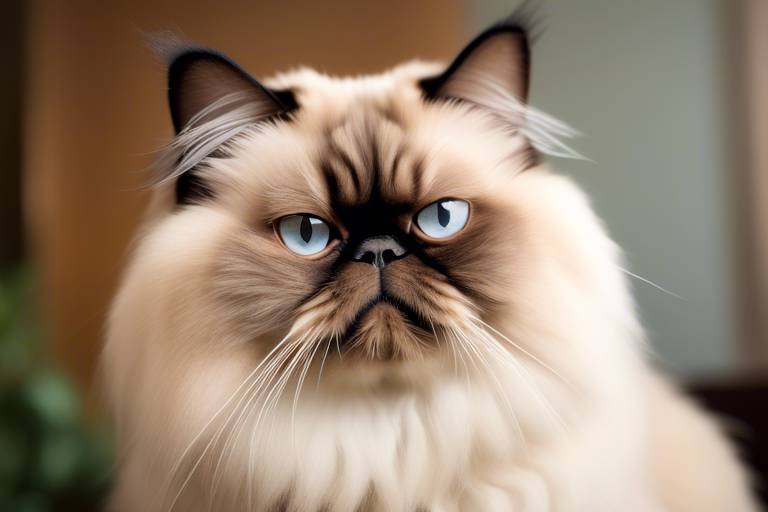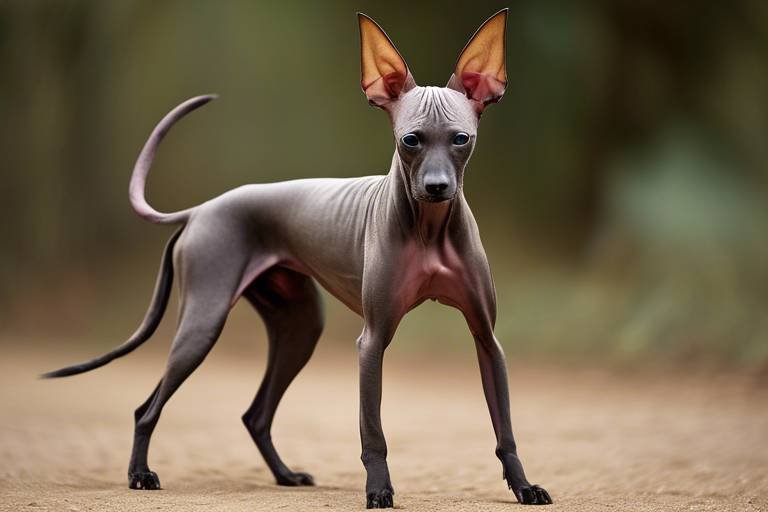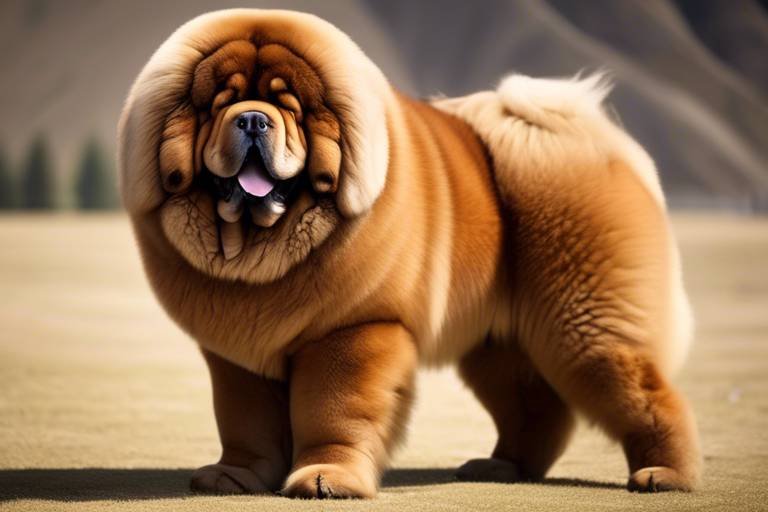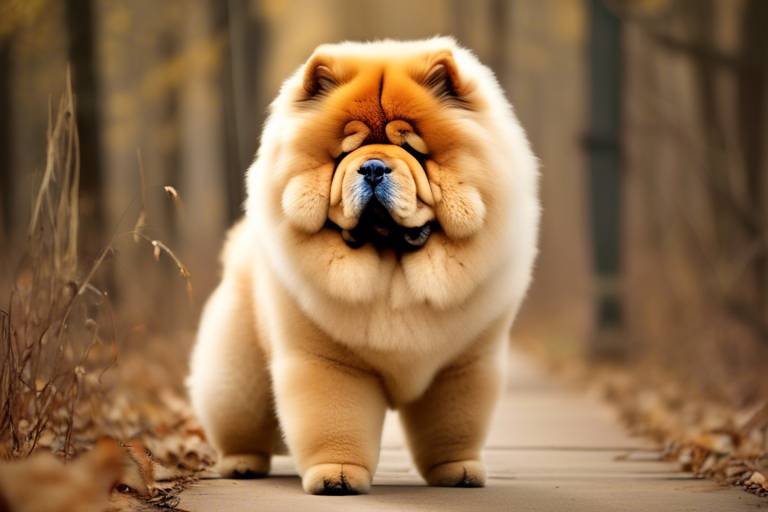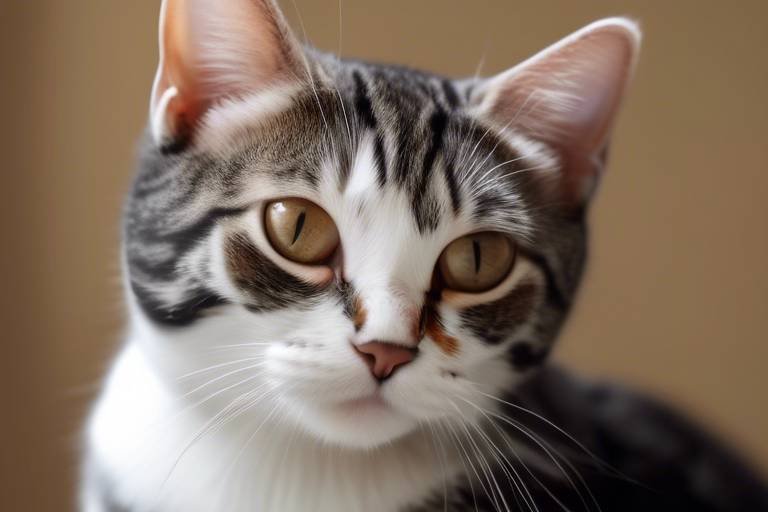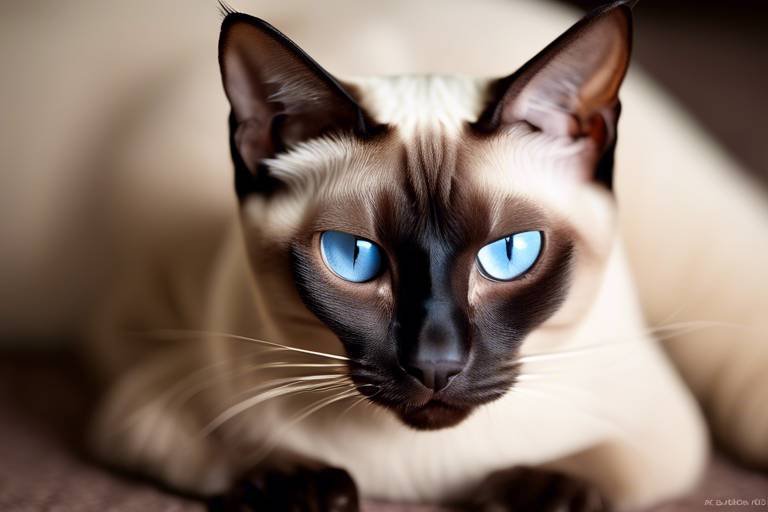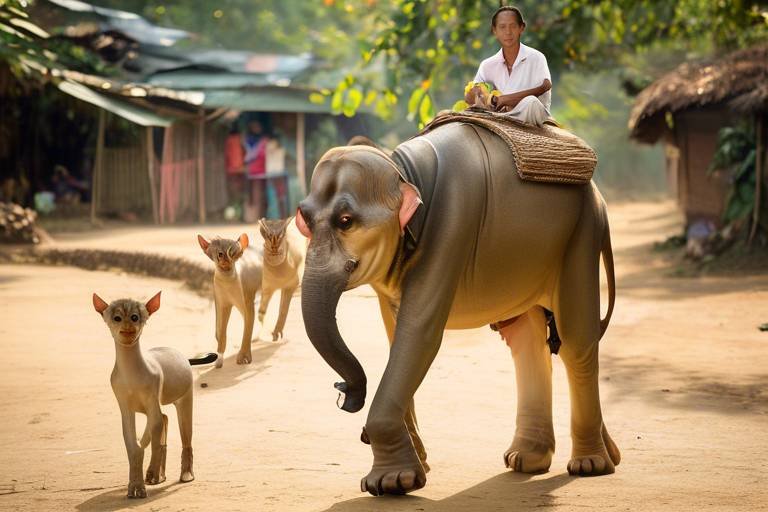Understanding the Affectionate Traits of the Himalayan Cat
The Himalayan cat is not just another breed; it embodies a unique blend of elegance and affection that captivates the hearts of cat lovers worldwide. Renowned for their stunning appearance and gentle demeanor, these cats are often described as the ultimate companions. Their affectionate nature is not just a coincidence; it's deeply rooted in their history, personality, and social behavior. If you’ve ever wondered why these fluffy felines have such a special place in the hearts of many, you’re in for a delightful exploration.
Imagine coming home after a long day, and there, waiting for you, is a beautiful creature with striking blue eyes and a soft, luxurious coat, ready to greet you with a gentle purr. This is the reality for many Himalayan cat owners. These cats are not just pets; they are family members, providing warmth and comfort that can only be found in their affectionate traits. But what exactly makes them so endearing? Let’s dive into the fascinating world of the Himalayan cat and uncover the secrets behind their lovable nature.
First off, their origins play a pivotal role in shaping their affectionate characteristics. The Himalayan cat breed was developed through a cross between the Persian and Siamese breeds. This lineage not only contributes to their stunning looks but also to their temperament. While Persians are known for their calm and gentle nature, Siamese cats are more vocal and social. The combination of these traits results in a cat that is not only visually striking but also deeply affectionate and engaging.
In terms of physical characteristics, Himalayans are truly breathtaking. Their long, flowing fur and captivating blue eyes create an image of elegance. But it’s not just their looks that draw people in; it’s their personality. Often described as gentle and loving, these cats possess a calm demeanor that makes them perfect for families, singles, and seniors alike. They have a knack for sensing emotions and can often provide comfort during tough times, making them the ideal companions.
Another fascinating aspect of their affectionate nature is their social behavior. Himalayan cats thrive on companionship and form deep, lasting bonds with their owners. They are known to follow their humans from room to room, seeking out interaction and affection. This strong attachment is a hallmark of their breed, making them incredibly loyal pets. In fact, many owners report that their Himalayans will curl up beside them at the end of a long day, offering warmth and love that is simply unmatched.
However, their affectionate nature comes with responsibilities, especially when it comes to grooming. Due to their long fur, Himalayans require regular grooming to keep their coats in pristine condition. This grooming ritual can be a wonderful bonding experience between cat and owner. Picture this: you and your Himalayan cat, spending time together while brushing their fur, creating a space of trust and love. It’s these moments that deepen the connection and enhance the affectionate traits of these lovely felines.
Despite their calm demeanor, Himalayan cats also have a playful side. They enjoy engaging in playtime, which not only stimulates their minds but also strengthens the bond they share with their humans. Whether it’s chasing a feather toy or pouncing on a laser dot, their playful antics can bring joy and laughter to any household. This playful nature is essential in maintaining a healthy relationship, as it allows for interaction that fosters affection.
Understanding how Himalayan cats communicate is crucial for deepening the bond between them and their owners. They express their affection through a variety of vocalizations and body language. A gentle purr, a soft meow, or even a slow blink can signify trust and love. By paying attention to these cues, owners can respond appropriately, reinforcing the affectionate connection they share.
Lastly, maintaining the health of a Himalayan cat is vital for their overall well-being. A healthy cat is more likely to exhibit affectionate behavior. Regular veterinary check-ups, a balanced diet, and proper exercise are essential components of keeping your feline friend happy and healthy. After all, a content cat is an affectionate cat!
In conclusion, the affectionate traits of the Himalayan cat are a delightful mix of their origins, physical characteristics, personality, and social behavior. They are not just pets; they are companions that offer love, warmth, and joy. By understanding and nurturing these traits, you can create a lasting bond with your Himalayan cat that will enrich both your lives.
- Do Himalayan cats require a lot of grooming? Yes, their long fur requires regular grooming to prevent matting and to keep their coat healthy.
- Are Himalayan cats good with children? Absolutely! Their gentle nature makes them great companions for children.
- How can I tell if my Himalayan cat is happy? Look for signs like purring, playful behavior, and seeking your company as indicators of a happy cat.
- What is the typical lifespan of a Himalayan cat? With proper care, Himalayan cats can live between 12 to 15 years or even longer.

Origins of the Himalayan Cat
The Himalayan cat breed boasts a fascinating history that intertwines with the stories of its parent breeds, the Persian and Siamese cats. This unique lineage began in the mid-20th century when breeders sought to create a cat that combined the striking color points of the Siamese with the luxurious, long fur of the Persian. The result? A stunning feline that not only captivates the eyes but also warms the heart with its affectionate nature.
To understand the affectionate traits of the Himalayan cat, it's essential to delve into its origins. The breed was officially recognized in the United States in the 1950s, and its popularity soared as cat lovers fell for its charming personality and beautiful appearance. The Himalayan cat is often described as a gentle giant, a term that perfectly encapsulates its demeanor. With a calm and loving temperament, these cats have become beloved companions for many families around the world.
The breeding process that led to the Himalayan cat involved meticulous selection to ensure that the new breed retained the best characteristics of its ancestors. Breeders aimed to create a cat that not only looked stunning but also had a sweet and affectionate personality. This endeavor was not just about aesthetics; it was about creating a loving companion that would thrive in a family environment.
Interestingly, the Himalayan cat's affectionate nature can be traced back to its Siamese lineage. Siamese cats are known for their vocal and social behaviors, which were blended with the more laid-back and gentle traits of the Persian. This unique combination resulted in a breed that is not only visually striking but also incredibly loving and loyal. As a result, Himalayans often form deep bonds with their owners, showcasing their affectionate side through cuddles, purring, and playful antics.
Today, the Himalayan cat is celebrated not just for its beauty but also for its loving nature. Whether you're a first-time cat owner or a seasoned feline enthusiast, understanding the origins of this breed can enhance your appreciation for its affectionate traits. So, as you snuggle with your Himalayan, remember that you’re not just sharing your home with a cat; you’re sharing your life with a breed that has been carefully crafted to be a loving companion.

Physical Characteristics
This article explores the unique affectionate characteristics of Himalayan cats, their behavior, and how these traits make them beloved companions for many cat lovers around the world.
The Himalayan cat breed has a rich history, originating from a cross between Persian and Siamese cats. Understanding their background helps explain their affectionate nature and distinctive features.
Himalayan cats are truly a sight to behold with their striking appearance. Their long, luxurious fur is one of the most defining features, often described as silky and soft to the touch. This fur comes in a variety of colors and patterns, but the most recognizable trait is their color-pointed coat, which means that the extremities (ears, face, paws, and tail) are darker than the rest of their body. This contrast creates a stunning visual effect that captivates many cat lovers.
Another remarkable feature of the Himalayan cat is their beautiful blue eyes. These large, expressive eyes not only enhance their charm but also seem to communicate a depth of emotion that many owners find irresistible. The combination of their eye color and facial structure, which includes a short muzzle and a rounded face, gives them a sweet and innocent appearance that melts hearts.
Here’s a quick overview of their key physical characteristics:
| Feature | Description |
|---|---|
| Fur | Long, silky, and color-pointed |
| Eyes | Large, round, and blue |
| Face | Round with a short muzzle |
| Body | Medium to large, muscular build |
Moreover, their body structure is medium to large, with a sturdy and muscular build. This robust physique allows them to be playful and active, despite their generally calm demeanor. When you see a Himalayan cat strutting around, you can’t help but admire their gracefulness, which adds to their overall charm as affectionate companions.
In summary, the physical characteristics of Himalayan cats are not just about aesthetics; they play a significant role in their affectionate nature. The soft fur invites petting, while their expressive eyes create a bond of understanding between the cat and its owner. It’s no wonder that these cats are cherished not only for their beauty but also for the warmth they bring into our lives.
Himalayan cats are often described as gentle and loving. Their calm demeanor makes them ideal pets for families and individuals seeking a warm and affectionate feline friend.
These cats thrive on companionship and often form strong bonds with their owners. Their social behavior is a key aspect of their affectionate nature, making them loyal and devoted pets.
Due to their long fur, Himalayans require regular grooming. This grooming process can enhance the bond between cat and owner, as it provides an opportunity for affectionate interaction.
Despite their calm nature, Himalayan cats enjoy playful activities. Engaging in playtime not only stimulates their minds but also reinforces the affectionate relationship they share with their humans.
Himalayan cats communicate through various vocalizations and body language. Understanding their unique ways of expressing affection can deepen the connection between the cat and its owner.
Maintaining the health of a Himalayan cat is crucial for their overall well-being. A healthy cat is more likely to exhibit affectionate behavior, making regular veterinary check-ups essential.
Providing a nurturing and loving home environment is vital for fostering the affectionate traits of Himalayan cats. Simple adjustments can enhance their comfort and strengthen the bond with their owners.
- Do Himalayan cats require special grooming? Yes, their long fur requires regular grooming to prevent matting and to keep them looking their best.
- Are Himalayan cats good with children? Absolutely! Their gentle nature makes them excellent companions for children.
- How much exercise do Himalayan cats need? While they are calm, they still enjoy playtime and should have opportunities to engage in physical activity.
- What is the lifespan of a Himalayan cat? With proper care, Himalayan cats can live between 12 to 15 years, sometimes longer.

Personality Traits
When it comes to personality, Himalayan cats are often described as the gentle giants of the feline world. Their demeanor is typically calm and serene, making them ideal companions for those who seek a loving and peaceful pet. Imagine curling up on the couch after a long day, with a fluffy Himalayan purring softly beside you—there's something incredibly soothing about their presence. These cats are affectionate by nature, often forming deep bonds with their owners, which can be likened to a warm embrace on a chilly evening.
One of the most endearing traits of Himalayan cats is their loving nature. They thrive on human interaction and are known to follow their owners from room to room, always eager to be part of the action. It's almost as if they have a built-in radar for when you need a little extra love or companionship. They are not just pets; they are members of the family, often displaying a remarkable ability to sense your mood. If you're feeling down, your Himalayan might curl up next to you, offering silent support and comfort.
Moreover, Himalayans are usually quite playful, despite their reputation for being calm. They enjoy engaging in interactive play, whether it’s chasing a feather toy or batting at a string. This playful side not only keeps them entertained, but it also reinforces the affectionate bond they share with their humans. You might find yourself laughing as your Himalayan pounces playfully, reminding you that they still have that kitten-like energy hidden beneath their luxurious fur.
Another fascinating aspect of their personality is their intelligence. Himalayan cats are quick learners and can be trained to follow simple commands or even perform tricks. This intelligence, combined with their affectionate nature, makes them highly rewarding companions. Imagine teaching your cat to fetch a toy or respond to their name—these small achievements can enhance the bond you share, creating a sense of teamwork and mutual respect.
In summary, the personality traits of Himalayan cats make them truly special companions. Their combination of gentleness, playfulness, and intelligence creates a loving atmosphere in any home. Whether they are snuggling with you on the couch or engaging in a playful romp, these cats have a unique way of making you feel cherished and adored. Embracing a Himalayan cat means inviting a bundle of affection into your life, and there’s nothing quite like the joy they bring.
- Are Himalayan cats good with children?
Yes, they are generally very gentle and patient, making them great companions for children. - How much grooming do Himalayan cats need?
Due to their long fur, they require regular grooming to prevent matting and to keep their coat healthy. - Do Himalayan cats get along with other pets?
Himalayans are usually sociable and can get along well with other cats and even dogs if properly introduced. - What is the lifespan of a Himalayan cat?
With proper care, Himalayan cats can live between 12 to 15 years, and sometimes even longer.

Social Behavior
Himalayan cats are not just pets; they are true companions that thrive on social interaction and form deep bonds with their humans. Unlike some breeds that may enjoy their solitary time, Himalayans are known for their affectionate nature and desire for companionship. They often seek out their owners, following them from room to room, as if to say, "Hey, I'm here! Let's hang out!" This behavior is a hallmark of their personality, showcasing their need for connection and love.
One of the most endearing aspects of a Himalayan's social behavior is their playful side. While they may have a calm demeanor, these cats love engaging in activities that stimulate their minds and bodies. Whether it’s chasing a feather toy or playing hide and seek, their playful antics can bring joy and laughter into any home. It's almost like having a furry little comedian at your side, ready to lighten the mood at a moment's notice.
Himalayans are also known to be quite vocal, using a range of sounds to communicate their feelings and desires. You might hear their soft, sweet meows or gentle purrs, which often signal their affection and need for attention. Understanding these vocalizations can help strengthen the bond between you and your feline friend, allowing you to respond to their needs more effectively. For instance, when they meow softly, it could mean they’re looking for some cuddle time, while a more insistent meow might indicate they’re ready for play.
Another important aspect of their social behavior is their adaptability within the family unit. Himalayans are known to get along well with children and other pets, making them an ideal choice for families. They are generally patient and tolerant, often enjoying the company of playful kids or other animals. This adaptability not only makes them great companions but also enriches the household dynamics, turning your home into a lively and loving environment.
To foster this social behavior, it's essential to create an environment where your Himalayan feels safe and loved. Regular interaction, whether through play, grooming, or simply lounging together, reinforces their affectionate traits. Remember, these cats thrive on routine and stability, so establishing a consistent schedule for feeding, playtime, and cuddling can greatly enhance their emotional well-being.
In summary, the social behavior of Himalayan cats is characterized by their desire for companionship, playful nature, and adaptability. By understanding and nurturing these traits, you can ensure a fulfilling relationship with your furry friend, one that is filled with love, laughter, and countless cherished moments.
- Do Himalayan cats get along with other pets? Yes, they are generally friendly and can adapt well to living with other pets.
- How can I encourage my Himalayan cat to be more social? Spend quality time playing, grooming, and interacting with them regularly.
- Are Himalayan cats vocal? Yes, they are known for their gentle vocalizations and will often communicate their needs.
- What is the best way to bond with my Himalayan cat? Engage in interactive play, provide affection, and maintain a consistent routine.
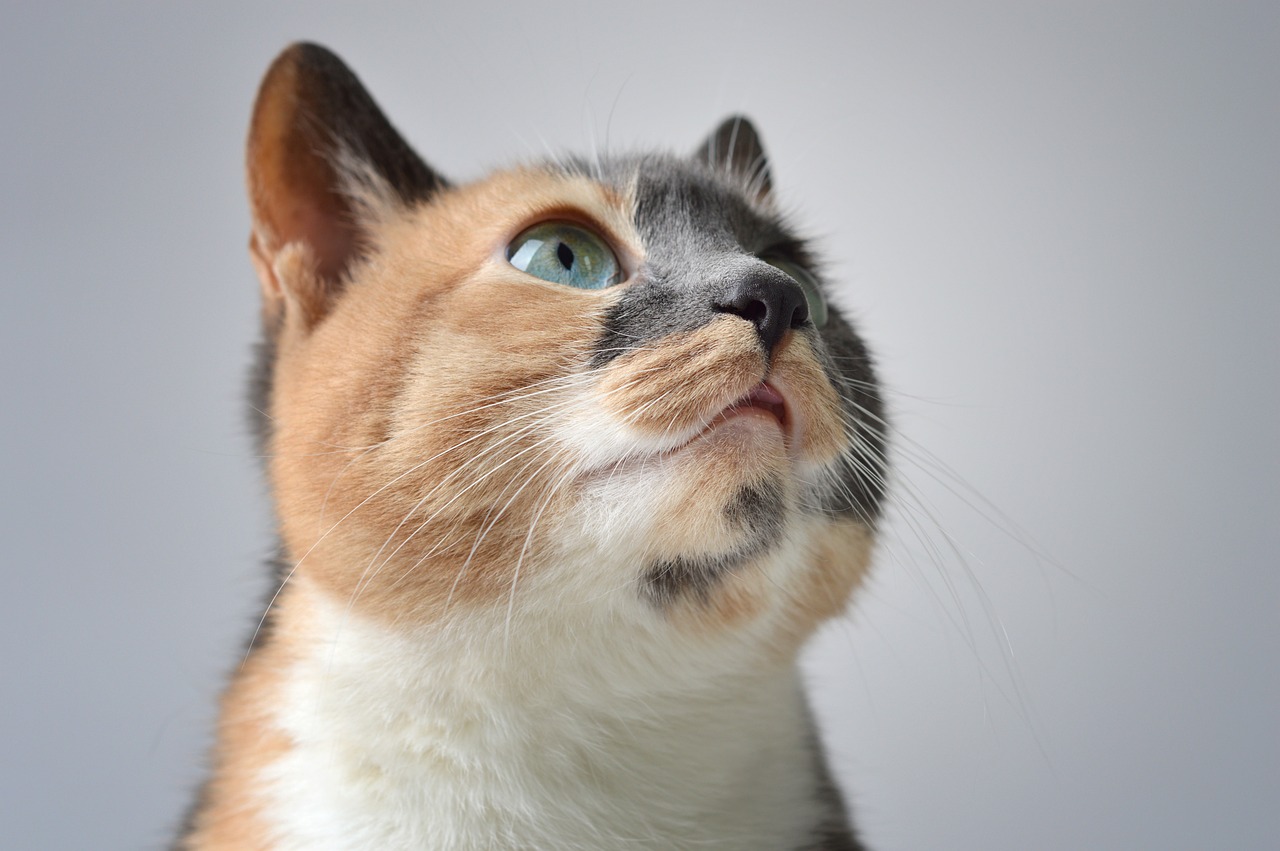
Grooming Needs
When it comes to grooming Himalayan cats, it's not just a chore—it's a delightful bonding experience! These stunning felines, with their luxurious long fur, require a bit of extra attention to keep their coats in top condition. Regular grooming is essential, not only to prevent matting and tangles but also to ensure their skin remains healthy and free from irritation. Imagine running your fingers through a soft cloud of fur; that's the kind of joy grooming can bring!
On average, it's recommended to brush your Himalayan cat at least two to three times a week. However, during shedding seasons, you might find yourself brushing daily to manage the extra fur. The grooming process can feel like a mini spa day for your cat, and they often enjoy the attention. Use a wide-toothed comb to gently detangle any knots, followed by a slicker brush to smooth out their coat. This not only helps keep their fur looking fabulous but also allows you to check for any skin issues or parasites.
Moreover, bathing your Himalayan cat occasionally can help maintain their pristine appearance. While they are generally good at self-grooming, a bath can remove any excess oils and dirt that brushing alone might miss. Just remember to use a cat-specific shampoo, as their skin has different pH needs compared to humans. After a bath, a thorough drying is crucial—Himalayan cats can easily catch a chill, so wrapping them in a warm towel can make them feel cozy and loved.
Grooming is also a fantastic opportunity to strengthen the bond between you and your furry friend. As you brush, talk to them in a soothing voice, and offer treats to create a positive association with grooming sessions. This can help your Himalayan cat feel secure and cherished, reinforcing their affectionate nature.
To summarize, here are the main grooming needs for your Himalayan cat:
- Brushing: 2-3 times a week, daily during shedding.
- Bathing: Occasionally, using cat-specific shampoo.
- Drying: Ensure they are thoroughly dried to prevent chills.
By dedicating time to grooming, you not only maintain their beauty but also enhance the affectionate bond that makes Himalayan cats such beloved companions. So grab that brush, and get ready for some quality time with your furry friend!
Q1: How often should I groom my Himalayan cat?
A1: It is recommended to groom your Himalayan cat at least two to three times a week, and daily during shedding seasons.
Q2: Can I bathe my Himalayan cat?
A2: Yes, you can bathe your Himalayan cat occasionally using a cat-specific shampoo. Just ensure they are thoroughly dried afterward.
Q3: What tools do I need for grooming?
A3: A wide-toothed comb and a slicker brush are essential for grooming Himalayan cats effectively.
Q4: How can I make grooming a positive experience for my cat?
A4: Talk to your cat in a soothing voice, offer treats, and be gentle during the grooming process to create a positive association.
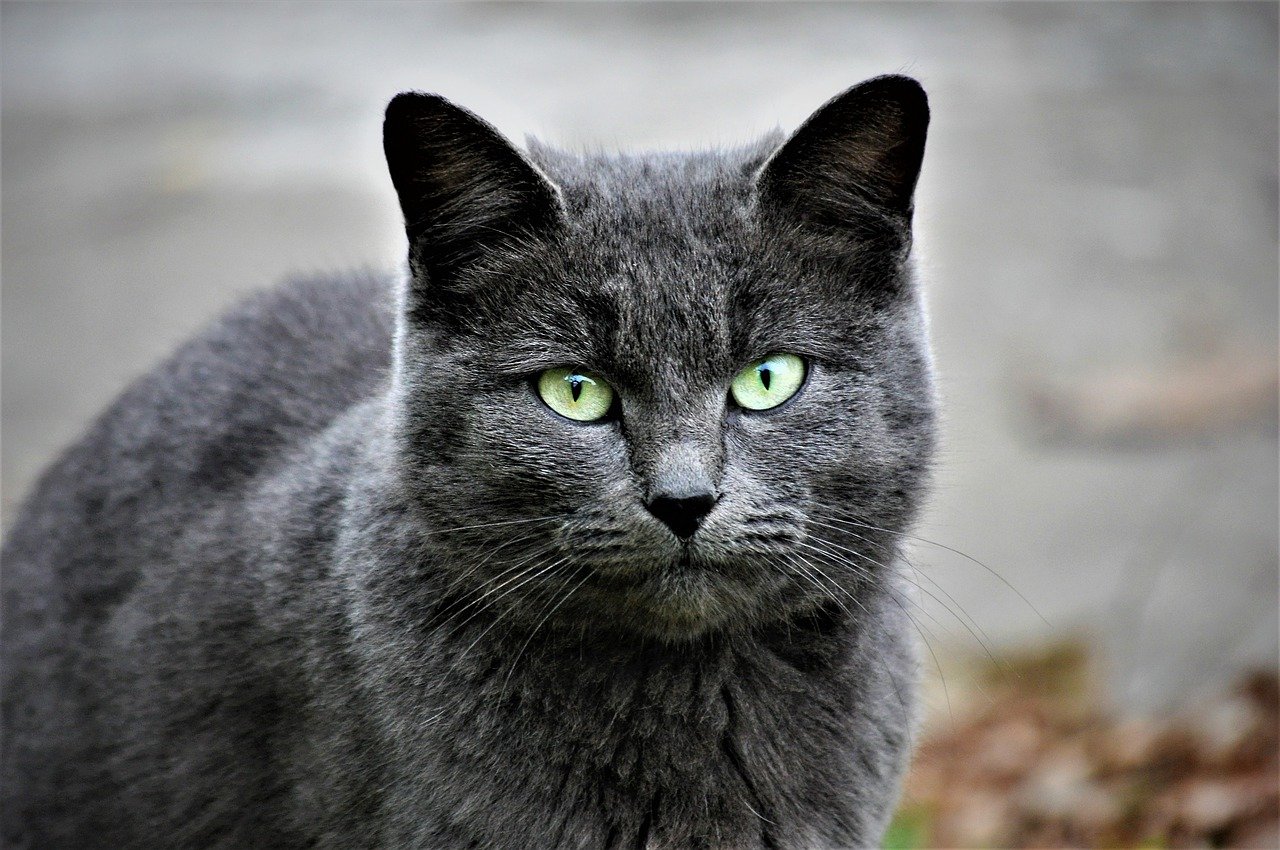
Playfulness and Affection
When you think of a Himalayan cat, you might picture a serene and fluffy creature lounging in a sunbeam, but don’t let their calm demeanor fool you! These delightful felines are not just about tranquility; they possess a playful spirit that can light up any room. Imagine a fluffy cloud suddenly bursting into a flurry of energy—this is what it feels like when a Himalayan cat decides it’s time to play. Their playful antics are not only entertaining but also a vital part of their affectionate nature.
Himalayan cats have a knack for turning ordinary moments into extraordinary ones. Whether it’s chasing after a feather toy or pouncing on a crumpled piece of paper, their playful behavior showcases their curiosity and zest for life. Engaging in playtime is essential for these cats, as it stimulates their minds and keeps them physically fit. In fact, regular play sessions can strengthen the bond between you and your furry friend, creating a delightful mix of affection and fun. After all, who doesn’t love a good game of chase?
Moreover, their playfulness often comes with a touch of affection. Picture this: as you toss a ball across the room, your Himalayan cat darts after it with glee, only to pause mid-chase to glance back at you, as if to say, “Did you see that?!” This interaction is not just about the game; it’s a shared experience that deepens your connection. By participating in their playful activities, you’re not just a spectator; you’re a partner in their world of fun!
In addition to toys, Himalayan cats enjoy engaging in interactive play that involves their humans. Activities such as using a laser pointer or wand toys can elicit joyful leaps and bounds. These moments are filled with laughter and warmth, reinforcing the affectionate bond you share. It’s these little bursts of playfulness that remind us why we love having them around. They have a unique ability to bring smiles and joy, transforming an ordinary day into something special.
To ensure your Himalayan cat remains playful and affectionate, consider incorporating a variety of toys into their environment. Here’s a quick table outlining some popular toy options:
| Toy Type | Description |
|---|---|
| Feather Wands | Great for interactive play, encouraging jumping and pouncing. |
| Laser Pointers | Provides endless entertainment as they chase the elusive dot. |
| Catnip Toys | Stimulates their senses and encourages playful behavior. |
| Ball Toys | Perfect for solo play, allowing them to bat and chase. |
In conclusion, the playfulness of Himalayan cats is an integral part of their affectionate nature. By embracing their playful side, you not only keep them happy and healthy but also create a deeper bond that lasts a lifetime. So, grab a toy and join in on the fun—your Himalayan friend is waiting for you to play!
- How often should I play with my Himalayan cat?
It's recommended to engage in play sessions at least once or twice a day, tailored to their energy levels. - What types of toys do Himalayan cats prefer?
Himalayan cats often enjoy feather wands, laser pointers, and soft toys filled with catnip. - Can I train my Himalayan cat to play fetch?
Yes! With patience and positive reinforcement, many Himalayan cats can learn to fetch small toys.

Communication Styles
When it comes to the of Himalayan cats, it’s like entering a world filled with soft whispers and gentle purrs. These felines have a unique way of expressing their feelings, and understanding their communication can truly enhance the bond you share. Unlike some cats that may be more vocal or aloof, Himalayans tend to communicate in a way that reflects their calm and affectionate nature.
One of the most notable aspects of their communication is their vocalization. You might hear them emit soft, melodious sounds that can range from a gentle meow to a more pronounced trill. These sounds are not just random noises; they are their way of conveying emotions, whether it’s a request for attention or simply a greeting. It’s almost as if they are serenading you, inviting you to share in their world.
In addition to vocalizations, Himalayan cats are masters of body language. Their posture and movements can tell you a lot about how they’re feeling. For instance, when they approach you with a relaxed body and a gentle sway of their tail, it’s a clear sign that they are feeling affectionate and comfortable. Conversely, if they puff up their fur or back away, they might be feeling threatened or anxious. Paying attention to these subtle cues can help you respond appropriately and strengthen your relationship.
Another fascinating aspect of their communication is the use of facial expressions. Just like humans, cats can convey a range of emotions through their eyes and facial muscles. When a Himalayan cat looks at you with half-closed eyes, it’s often referred to as a “cat kiss,” a sign of trust and affection. If you reciprocate this by slowly blinking back at them, you’re engaging in a silent yet powerful form of communication that deepens your bond.
Moreover, these cats are known for their affectionate gestures. They might nuzzle against you or gently knead with their paws, actions that signal comfort and love. These behaviors are not just cute; they are essential for creating a nurturing environment where both you and your cat feel secure. Engaging in these moments of affection can be incredibly rewarding, as it fosters a sense of companionship and trust.
To summarize, understanding the communication styles of Himalayan cats involves observing their vocalizations, body language, and affectionate gestures. By tuning into these signals, you can create a deeper connection with your feline friend, enriching both your lives. Just like a beautiful melody, the way they communicate is a harmonious blend of sound and movement, inviting you to join in their symphony of love.
- Do Himalayan cats communicate differently from other breeds?
Yes, Himalayan cats tend to be more gentle and soft in their vocalizations compared to some other breeds, making their communication style unique. - How can I improve communication with my Himalayan cat?
Pay attention to their body language and vocalizations, and respond with gentle affection to strengthen your bond. - What does it mean when my Himalayan cat blinks at me?
This is a sign of trust and affection, often referred to as a “cat kiss.” It’s a wonderful way for them to express their love.

Health Considerations
When it comes to the health of your Himalayan cat, there are several key factors to consider to ensure your furry friend remains happy and affectionate. Just like humans, cats require regular check-ups to monitor their health. Himalayans are prone to certain genetic conditions, such as polycystic kidney disease and respiratory issues, which can affect their quality of life. Regular veterinary visits can help catch these issues early, allowing for timely intervention.
Another critical aspect of maintaining your Himalayan's health is their diet. A well-balanced diet rich in nutrients is essential for their overall well-being. It's important to choose high-quality cat food that is specifically formulated for their breed. Look for options that contain:
- High protein content to support muscle development
- Omega fatty acids for healthy skin and coat
- Vitamins and minerals to boost their immune system
Hydration is equally vital. Make sure your Himalayan has access to fresh water at all times. Dehydration can lead to serious health issues, particularly in cats that are prone to kidney problems. You might even consider a cat water fountain, as many cats prefer running water and are more likely to drink enough throughout the day.
Additionally, regular grooming plays a significant role in your Himalayan's health. Their long fur can easily become matted if not cared for properly. Daily brushing not only keeps their coat looking beautiful but also helps reduce the risk of skin infections and discomfort. During grooming sessions, you can also check for any unusual lumps or bumps, which can be early signs of health issues.
Lastly, it’s essential to provide your Himalayan with a stimulating environment. Boredom can lead to stress and anxiety, which may manifest in unhealthy behaviors. Engage your cat with toys, climbing structures, and interactive playtime. A happy cat is often a healthy cat, and creating a loving environment will help nurture their affectionate nature.
| Question | Answer |
|---|---|
| What are common health issues in Himalayan cats? | Himalayan cats are prone to polycystic kidney disease, respiratory issues, and dental problems. |
| How often should I take my Himalayan to the vet? | Regular check-ups every 6 to 12 months are recommended to monitor their health. |
| What is the best diet for Himalayan cats? | A high-protein, nutrient-rich diet formulated for their breed is ideal. |
| How can I keep my Himalayan's coat healthy? | Regular grooming, at least once a day, is essential to prevent matting and skin issues. |

Creating a Loving Environment
Creating a loving environment for your Himalayan cat is essential to nurture their affectionate traits and overall happiness. These cats thrive in spaces that are not just comfortable, but also filled with love and attention. Imagine your home as a cozy haven where your feline friend feels safe and cherished. The atmosphere you cultivate can significantly influence their behavior and emotional well-being.
One of the first steps in establishing a loving environment is to ensure that your home is cat-friendly. This means providing ample space for your Himalayan to roam, play, and explore. Cats are naturally curious creatures, and they need a stimulating environment to keep their minds active. Consider investing in cat trees or shelves that allow them to climb and survey their surroundings from a height. This not only satisfies their instinctual behaviors but also adds a layer of excitement to their daily routine.
Another important aspect is to create a safe and quiet space where your Himalayan can retreat when they need some alone time. This could be a cozy corner with a soft bed or a designated room where they can feel secure. Cats, especially Himalayans, can be sensitive to noise and chaos, so having a sanctuary where they can unwind is crucial. You might even consider placing their favorite toys or blankets in this space to make it even more inviting.
Additionally, daily interaction is vital for fostering affection. Spend quality time with your Himalayan by engaging in activities that they enjoy. Whether it’s gentle brushing, interactive play with feather wands, or simply cuddling on the couch, these moments strengthen your bond. Your Himalayan cat will thrive on your attention and affection, which will, in turn, encourage them to reciprocate with their own love and companionship.
Moreover, the importance of a consistent routine cannot be overstated. Cats are creatures of habit, and establishing a routine for feeding, playtime, and grooming can create a sense of stability for your Himalayan. This predictability helps them feel secure and loved, knowing what to expect each day. A well-structured environment can significantly reduce stress and anxiety, allowing your furry friend to flourish.
Finally, it’s essential to provide a nutritious diet and regular veterinary care. A healthy cat is a happy cat, and ensuring your Himalayan receives proper nutrition will contribute to their overall well-being. Regular check-ups with a veterinarian will help catch any potential health issues early, ensuring your cat remains vibrant and affectionate throughout their life.
In conclusion, creating a loving environment for your Himalayan cat involves a combination of physical comfort, emotional support, and consistent care. By paying attention to their needs and providing a nurturing atmosphere, you will not only enhance their affectionate nature but also enjoy a deeper bond with your feline companion.
- How can I tell if my Himalayan cat is happy? Look for signs of contentment such as purring, kneading, and a relaxed body posture. Happy cats often seek out interaction and enjoy being near their owners.
- What is the best way to groom my Himalayan cat? Regular brushing is essential for their long fur. Aim for at least two to three times a week to prevent matting and reduce shedding.
- Are Himalayan cats good with children? Yes, they are generally gentle and affectionate, making them great companions for children, provided they are introduced properly and treated with respect.
- How often should I take my Himalayan cat to the vet? Regular check-ups at least once a year are recommended, but older cats or those with health issues may require more frequent visits.
Frequently Asked Questions
- What are the affectionate traits of Himalayan cats?
Himalayan cats are known for their gentle and loving nature. They tend to form strong bonds with their owners, often seeking companionship and affection. Their calm demeanor makes them ideal pets, as they enjoy cuddling and being around their humans.
- How do I groom my Himalayan cat?
Grooming a Himalayan cat requires regular brushing to prevent matting of their long fur. It's best to use a wide-toothed comb and a slicker brush. Make grooming a fun and affectionate time by talking to your cat and offering treats, which can help strengthen your bond.
- Are Himalayan cats playful?
Absolutely! While they have a calm demeanor, Himalayan cats also love to play. Engaging them in interactive playtime with toys not only keeps them mentally stimulated but also reinforces the affectionate relationship you share.
- How can I create a loving environment for my Himalayan cat?
Creating a loving environment involves providing a safe and comfortable space for your cat. Ensure they have cozy spots to relax, toys to play with, and plenty of attention from you. Simple things like a warm bed or a sunny window perch can enhance their comfort and happiness.
- What health considerations should I keep in mind for my Himalayan cat?
Regular veterinary check-ups are essential to maintain your Himalayan cat's health. Be aware of common health issues in the breed, such as respiratory problems and dental issues. A healthy cat is more likely to be affectionate and active, so keeping up with their health is crucial.
- How do Himalayan cats communicate their affection?
Himalayan cats communicate through various vocalizations, like soft meows and purrs, as well as body language, such as rubbing against you or kneading. Understanding these signals can deepen your connection and help you recognize when they’re seeking affection.

